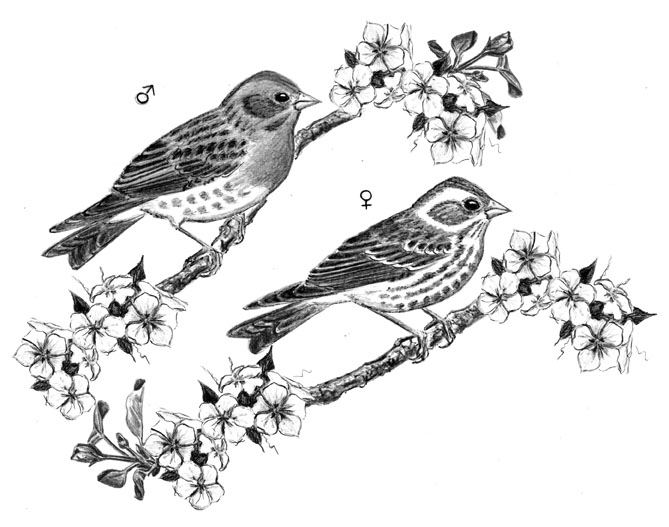
Dear Bird Folks,
I was in your store the other day and told the woman behind the counter that I had a pair of Purple Finches coming to my feeder. I even described them to her. She looked at me with a suspicious eye and suggested that the birds I was seeing were House Finches. So I went home and took the attached photos. They sure look like Purple Finches to me.
– John, Mashpee, MA
They are Purple Finches, John,
You would think that people who have spent the past eighty-six years working in a birding store would be better at identifying birds, but sometimes their focus is on other things. Instead of birds, they seem to be more interested in discussing dogs, horses, dogs, fashion and dogs. That’s just their way. I’ve got an idea. The next time you come in to our shop tell whoever is working that you saw a stylish purple dog riding a horse around your feeder. They still might not believe you, but they’ll be happy to talk about it.
To be fair, 99.999% of the Purple Finch reports we receive each year turn out to be a House Finch. The reason for this misidentification is because House Finches are extremely common in our area and they look very similar to the less common Purple Finch. In addition, many older bird books only included Purple Finches because House Finches didn’t breed in the eastern half of North America until the early 1940s. But I think the real reason folks claim to have Purple Finches is because they like saying the name. It just sounds better. The name House Finch has a creepy quality. It reminds me of a nickname given to a recluse or a hoarder. Parents might tell their children, “Don’t go in that yard, kids. Old man Jackson lives there. He’s a house finch.” Purple Finch is a less threatening name. Plus, it sounds like it has to do with fashion.
Purple Finches are handsome, well-marked birds and not long ago were the most common red finches in these parts. Then, in 1939, House Finches were illegally introduced to New York from the West Coast and their population exploded. As the number of these western birds multiplied the population of Purple Finches began to decline. Even though Purple Finches are the larger of the two birds, they weren’t able to compete with the more assertive western finches. It’s hard to imagine that something from the West Coast could be more aggressive than anything from New York, but it happened. Some researchers believe that the decline of the Purple Finches is actually related to environmental factors and not caused by pushy House Finches. This may be true, but an invasion of belligerent birds from the West makes for a better story.
As I mentioned earlier, 99.999% of the red finches we see on feeders in our area are House Finches. Not only are these birds common at feeders, but they are also frequent nesters. As their name suggests, these birds like houses – but not birdhouses, our houses. House Finches are the birds that build their nests in our hanging plants, on our porch lights or in old Christmas wreaths still hanging on the doors of people who think they are saving money by using the same wreath several years in a row.
Like Downey and Hairy Woodpeckers, these two finches are easily distinguishable when they are side-by-side, but when does that ever happen? When it comes to trying to tell which bird is which, my advice is to look at the wings and backs. Both birds have red on their heads, chests and at the base of their tails, but House Finches have brown wings and brown backs (when the wings are closed). The backs and wings of Purple Finches have a fair amount of red coloring blending in with the brown feathering. Remember back in the ‘80s when people got their hair frosted? Well, Purple Finches are still doing it; only they are using red frosting, which is the most delicious of all the frostings.
It’s important to note that only the male finches have red coloring. The females of both species are streaky brown, looking sparrowish. However, the female Purple Finch has a distinct white stripe above each eye, which helps with identification. Occasionally, the male finches are subject to a condition known as “xanthochromism.” Through either diet or genetic factors, they are sometimes tinged with yellow where the red should be. This condition isn’t common but it does happen. Xanthochromism is a good word to know. You can use it if you play Words With Friends, or one of those other time-sucking computer games. Once you’ve used xanthochromism, you’ll win the game and will be free to actually do something productive for the rest of the day.
Because of the aggressiveness of House Finches, many Purple Finches tend to avoid urban feeders and are more likely seen in the boonies. So you are indeed lucky to have Purple Finches in Mashpee, John. (Although, most people on the Outer Cape think of Mashpee as being in the boonies.) One last thing: I’ll encourage my staff to improve their bird identification skills so hopefully they’ll be better prepared to answer your questions the next time you visit us. However, if learning about birds somehow interferes with their on-going discussions of dogs, horses, dogs, fashion and dogs, it probably isn’t going to happen.